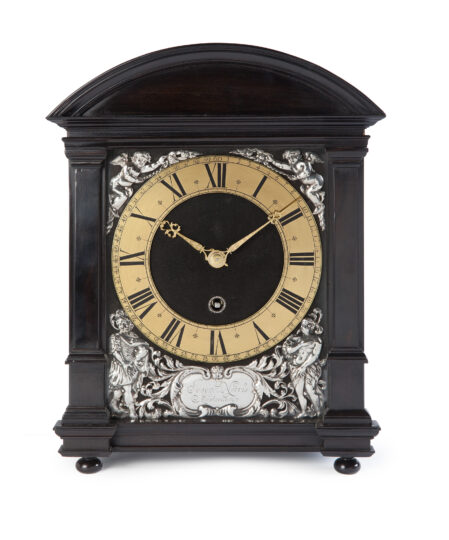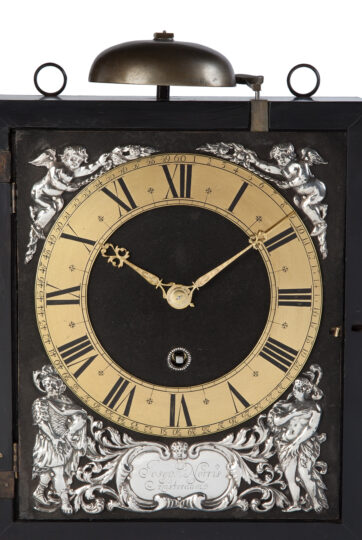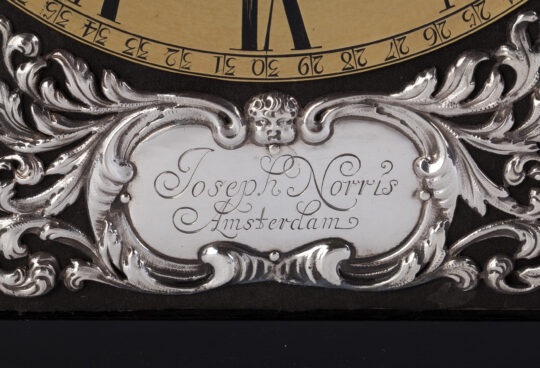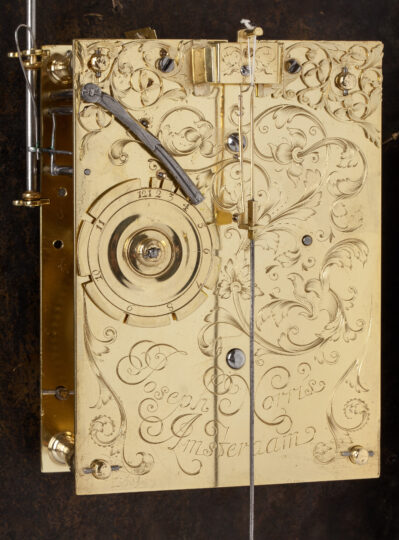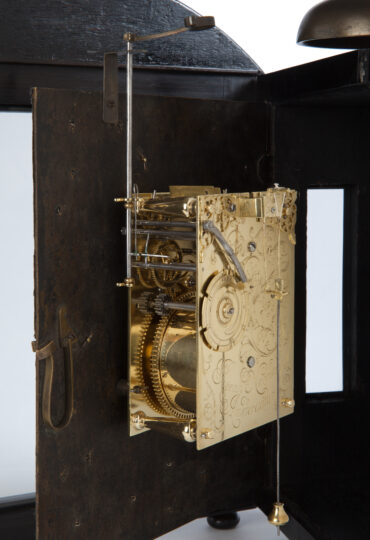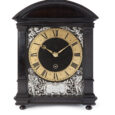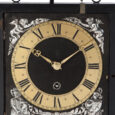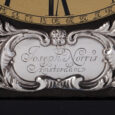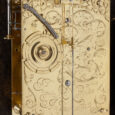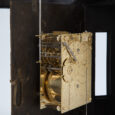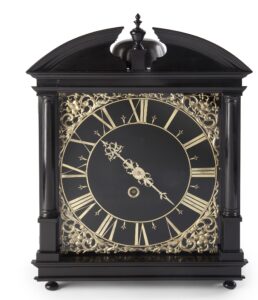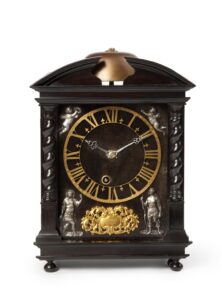HAGUE CLOCK Joseph Norris Amsterdam Ca. 1680 The Netherlands
M&R38
HAGUE CLOCK
Signed: Joseph Norris Amsterdam
Circa 1680
The Netherlands
Movement
The eight-day movement of this Hague clock has going and striking trains each with five wheels, driven by a single barrel. The going train has verge escapement, the verge directly attached to the pendulum. The hour striking indicates the hours on a bell mounted on the top of the case, hidden by an arched, moulded pediment. It is regulated by a count wheel with Arabic numerals indicating the position of the striking train. The backplate is engraved with foliate and floral patterns (English influence) and has an elaborately pierced and engraved back cock and the signature Joseph Norris Amsterdam.
Dial
The black-velvet covered dial can be turned outwards on hinges to the left. It has a brass chapter ring with Roman hour division, half-hour and quarter divisions, as well as Arabic minute division. The time is indicated by a pair of pierced and engraved gilt-brass hands. There are two cast-silver winged-cherub spandrels in the upper corners, which stretch out an arm toward each other, whilst below the chapter ring there is an elaborate repoussé cartouche, forming a unity with the lower corner spandrels. The cartouche is signed Joseph Norris Amsterdam.
Case
The arched case of the Hague clock is made of ebony-veneered oak. The front door is flanked by plain flat pillars with wooden capitals and large bases, whilst the sides have glazed rectangular panels with moulded frames. At the rear side of the top of the case there are two suspensions eyes, making the clock both a table and a wall clock. The whole rests on four ball feet.
Duration 1 week
Height 39 cm
Width 29 cm
Depth 29 cm.
Literature
– E. Morpurgo, Nederlandse Klokken- en Horlogemakers vanaf 1300, Amsterdam, 1970, p. 93;
– R. Plomp, Spring-driven Dutch Pendulum Clocks, Schiedam, 1979, p. 167;
– H.M. Vehmeyer, Clocks – Their Origin and Development 1320 – 1880, Gent, 2004, pp. 344-345, 985.
The maker
Joseph Norris, was born in Abingdon near Oxford in 1650. He was the younger brother of Edward Norris (1637-1726). At the age of 12 he became Edward’s apprentice for a period of eight years. He survived the plague and the Great Fire of London in 1665 and 1666 respectively, but as a result of the latter the brothers had to move from ‘The Crossed Keys’ in Lothbury to Dove Court. In September 1670 he became free of the Clockmakers’ Company, at the same time as Joseph Knibb, who moved from Oxford to London in that year. After the peace treaty between England and the Netherlands in 1674 he went to Amsterdam and settled there. Although the timing of Norris’s step was clearly connected with the end of the Anglo-Dutch war, the reason why he took it is not certain. It may have been due to the fact that his former mentor Ahasuerus (I) Fromanteel had been there since 1667; Norris did not return to England until 1692. It is quite likely that Joseph Norris was the first to make longcase clocks with a ‘Royal Pendulum’ in Holland, starting in or immediately after 1675, as Fromanteel imported them complete from England. Joseph Norris lived near the Beurs (the ‘Exchange’) on Damrak in Amsterdam, where he also had his workshop. In 1677 he married Alicia Arnold from Tonstell (probably Tunstall, Kent), England in the English Reformed Church. He quickly became one of the city’s leading clockmakers. In 1692 he returned to Abingdon, where he held numerous prominent positions in public and clerical life until his death in 1726.

